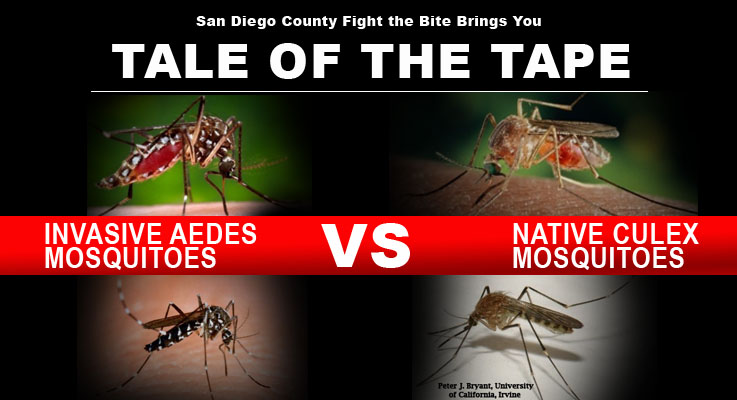San Diego County and its residents have been fighting West Nile virus and native mosquitoes for more than a decade. This year, we’ve also had to deal with invasive Aedes mosquitoes and their disease-carrying potential.
Now more than ever, you need to know your vectors! And how to protect yourself!
| Aedes | Culex | |
| Aedes aegypti — yellow fever mosquito Aedes albopictus — Asian tiger mosquito |
Name, Species |
Culex Tarsalis: western encephalitis mosquito Culex Quinquefasciatus: southern house mosquito |
| Transmitting tropical diseases like Zika virus, dengue, chikungunya, yellow fever — by first biting an infected person, then someone else. | Best Known For |
Transmitting West Nile virus — by first biting an infected bird or animal, then biting a person. |
| Invasive — Hail from the tropics. First found in San Diego County in 2014 and 2015. | Origin |
Native |
| Smaller than our native mosquitoes, and “pretty” (you know, for a mosquito) with distinctive black and white markings | Size, Markings |
Culex tarsalis is a little bigger than the Aedes species, but also has black and white stripes. Quinquefasciatus is dull grey in color. |
| YOU. People are definitely their preferred menu item, but they’ll also feed on other critters as well. | Favorite Food |
They prefer birds — birds and animals. But they will bite people too. |
| Daytime. Big difference between Aedes and culex mosquitoes. Aedes like to bite during the day. They’ll also bite around dusk and dawn, but rarely at night, when culex mosquitoes are munching. | Favorite Time to Bite | Mostly between dusk and dawn — definitely at night. They don’t bite during daylight hours. |
| Inside your house! In your yard! These guys love to live in urban and suburban areas — right next to you! | Hangouts |
Outside. They’ll come inside your home if you let them, through a torn window screen or an open door. But you’re going to run into them most often outside — playing, hiking, picnicking, gardening; near stagnant streams, creeks, or bird baths, Koi ponds, fountains and stagnant pools. |
| Aedes like to breed around people, in homes or in yards, in small amounts of water like in tree holes or the saucers under flower pots. Their eggs can go six months without water — then get submerged by water from rain or sprinklers and boom! Instant mosquito larvae. A week later, mosquitoes! | Where they Breed | Culex lay 200 to 300 eggs at a time in rafts on stagnant water sources. |
| The prevailing wisdom is that Aedes aren’t strong fliers, with flight ranges of about 150 yards or so. | Estimated Flight Range |
Culex Tarsalis can fly up to five miles. Culex quinquefasciatus is not as strong a flier, traveling up to 1/2 mile or so. |
| Prevent, Protect, Report — with heavy emphasis on the Prevent side. Empty out all standing water inside and outside your home so Aedes can’t breed. Report to Vector Control if you’re getting bitten during daylight hours. | Best Defense |
Prevent, Protect, Report Report to Vector Control if you know water sources where mosquitoes are breeding. Wear insect repellent, long sleeves and long pants when out around dusk and dawn. |
When is the fight date? Every day; right in your yard!
So remember:
Prevent mosquito breeding
Dump out or remove any item inside or outside of homes that can hold water, such as plant saucers, rain gutters, buckets, garbage cans, toys, old tires, and wheelbarrows. Mosquito fish, available for free by contacting the Vector Control Program, may be used to control mosquito breeding in backyard water sources such as unused swimming pools, ponds, fountains and horse troughs.
Protect yourself from mosquito bites
Protect yourself from mosquito-borne illnesses by wearing long sleeves and pants or use repellent when outdoors. Use insect repellent that contains DEET, picaridin, oil of lemon eucalyptus, or IR3535. Make sure screens on windows and doors are in good condition and secured to keep insects out.
Report possible mosquito activity
Report if you are being bitten by mosquitoes during daylight hours, or if you find mosquitoes that match the description of Aedes mosquitoes by contacting the Vector Control Program at (858) 694-2888.
Information about the Zika virus, chikungunya, and dengue and can be found on the National Centers for Disease Control and Prevention’s website.
For more information about mosquito-borne illnesses virus, go to San Diego County’s “Fight the Bite” website.






